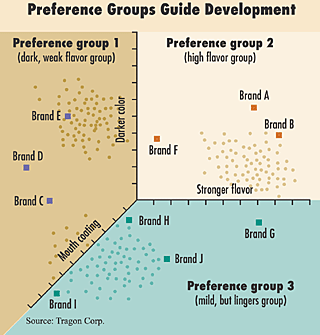Sensory work is designed to help manufacturers optimize product attributes to please their target audience. To obtain quality information, logistics and methods must be adapted to customs and conditions in other countries.
Logistics and Languages
Researchers at Tragon Corp., Redwood City, Calif., have developed an expertise in conducting on-site tests internationally. It is essential to work with local sensory testing firms, market research companies and other affiliates familiar with the culture, according to Joel Sidel, executive vice president and co-founder. Even so, logistics are different than in the U.S.“Getting the right product to the test site can be a consideration,” says Sidel. “There are differences in labeling laws among different countries; there are different approved ingredients. We have had products held up in quarantine, and if they contain unapproved ingredients, we can't test them.”
“Test sites, especially for consumer tests, need to be close to target consumers. Noise, lighting and aroma can cause problems.”

In addition, a product may be used differently in various regions. It can be used in its original form, or as an ingredient in other foods. Such factors must be considered, otherwise, the data doesn't relate to the population. “The product must make sense to the test subjects,” Sidel adds.
Understanding the Locals
In the U.S., potential consumer panelists are contacted by telephone, pre-screened and pre-tested. In other countries, people may be unaccustomed to telephone contacts. Researchers may need to go door-to-door or stop people on the street to determine if they qualify to be a panelist.Some researchers test two or three products and ask many questions. Tragon's researchers instead use a broad array of products to get adequate amounts of meaningful data. Testing may take place over three or four days and cover six to eight products a day. Test products must be somewhat differentiated, yet not be so different that data is distorted.
Some concepts are universal to all nations. One is the discovery of preference clusters that cut across demographic lines. (See chart.) “If the cluster is large enough, it can be good business,” says Bruce Yandell, vice president. Populations tend to prefer less “sensory distinctive” products when they're first introduced. “As the global market changes, consumers are offered more choices, and there are more variations.”
For more information: Joseph Salerno at 650-365-1833 jsalerno@tragon.com • www.tragon.com Tragon Corp. • Write in 23